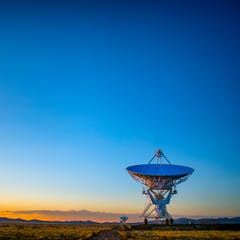
Articles on Space
Displaying 121 - 140 of 754 articles

The way particles interacted while the universe was forming seconds after the Big Bang could explain why the universe exists the way it does – a physicist explains matter-antimatter asymmetry.

Both Stephen Alexander’s elementary teachers and televised NASA missions throughout the ‘60s influenced his journey into science. He recounts NASA’s legacy, 65 years after the agency’s inception.

Three Indigenous studies scholars draw from colonial histories and explain why listening for alien life can have ethical ramifications.

Ready or not, sex in space will be happening within the decade.

While a return to the Moon will allow the U.S. to collaborate with other nations interested in space, this endeavor is also complicated by geopolitical tensions.

While UFO videos might seem compelling, they’re rarely backed up with evidence. A sociologist explains why claims of alien life gain traction through both social and mass media every few years.

Astronomers have detected the coldest star ever found to emit radio waves using the Australian SKA Pathfinder telescope.

Space telescopes are limited in size due to the difficulties and cost of getting into orbit. By revamping an old optical technology, researchers are working on a lightweight and thin telescope design.

If you haven’t seen Stanley Kubrick’s 1968 sci-fi classic, then it’s likely you will have seen other films influenced by it.

With a solar eclipse and several meteor showers coming up, an astronomy professor shares travel tips for viewing astronomical phenomena.

Astronomers have for the first time detected the background hum of gravitational waves likely caused by merging black holes.

The planet Halla looks like it should have been devoured by its host star, a red giant called Baekdu – but a secret in the star’s past may hold the answer to the planet’s present.

Advances in technology have allowed tourists to go to places and do things they couldn’t in the past. But in extreme environments, the consequences of failure are high.

President Erdoğan has been hoping his government’s science wins would spark a wave of patriotic support.

Upgrades to the hardware and software of the advanced observatory should allow astrophysicists to detect much fainter gravitational waves than before.

Our Sun will likely go out quietly – but not all such stars do. A new radio detection of a supernova can help us better understand these cosmic cataclysms.

Why is the space sector struggling to attract a more diverse talent pool? We have a few solutions that could help.

Stars begin to expand when they run out of fuel and can become thousands of times larger, consuming any planets in the way. For the first time, astronomers have witnessed one such event.

A spacecraft set to launch this year will throw a spotlight on the mysterious ‘dark side’ of the universe.

Not all lunar eclipses are alike. An astronomer explains the science behind the slight dimming of the Moon on May 5, 2023.





